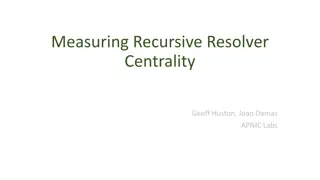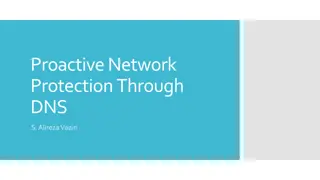Automating DNS Maintenance with Catalog Zones: A New Approach
"Explore a fresh method for automating maintenance in DNS servers through catalog zones, focusing on dynamic configuration data. Learn about generating includes for various DNS daemons and enhancing zone management efficiency. Discover how to streamline provisioning and loading processes with Python, Jinja, and YAML. Delve into updating and organizing zone information within the DNS daemon for improved functionality and scalability."
Download Presentation

Please find below an Image/Link to download the presentation.
The content on the website is provided AS IS for your information and personal use only. It may not be sold, licensed, or shared on other websites without obtaining consent from the author.If you encounter any issues during the download, it is possible that the publisher has removed the file from their server.
You are allowed to download the files provided on this website for personal or commercial use, subject to the condition that they are used lawfully. All files are the property of their respective owners.
The content on the website is provided AS IS for your information and personal use only. It may not be sold, licensed, or shared on other websites without obtaining consent from the author.
E N D
Presentation Transcript
Extending Catalog zones another approach in automating maintenance Leo Vandewoestijne dns.company Rev 0.000
Spoilers/Warnings - Not much new; working in Bind already - This presentation was prepared while having lack of time
Introduction Currently you may use python/jinja/yaml to generate includes for Bind, NSD, Knot, Yadifa, etc. Which then need to be provisioned, and then loaded. Catalog zones are DNS zones containing dynamic configuration, or better said configuration data : the domain zones to be loaded/unloaded) in your DNS daemon. In this presentation the main configuration is not addressed (see ISC examples), but focussed on the catalog zone itself.
old code $ORIGIN catzone. $TTL 14400 @ IN SOA . . 1552507036 86400 14400 86400 14400 @ NS invalid. @ ZONEMD 1552507036 1 0 ( 4ac63blablablaetc ) version 0 IN TXT "1" $ORIGIN zones.catzone. 2994957a552f357f9e49007e0462d3617354e9df PTR alila.dog. 3d5f1f25bf803861058ec11a929e38c134cbc1f6 PTR trouwauto.limo. 2994957a552f357f9e49007e0462d3617354e9df PTR trouwauto.wedding. 038aa43b8bf77211435f57ad25bcc1e6ba7b0e05 PTR unicycle.show. 43f984676423c0a9c30c8c635b3757dd2f820dff PTR malabarista.coffee. 019559dd498f0b289662322fceb8f0c431d92193 PTR globeofdeath.com. 4498690ad458ebc22eeffb86ba2b7a1f181c3942 PTR iomammetaetu.pizza. NOTE: to generate the hash used in ISC s examples: print hashlib.sha1(dns.name.from_text("example.tld").to_wire()).hexdigest() # or printf '\7example\3tld\0' | openssl sha1
$TTL 14400 extended code version 0 IN TXT "1" @ IN SOA . . 1552507036 86400 14400 86400 14400 @ NS invalid. @ ZONEMD 1552507036 1 0 ( 4ac63blablablaetc ) $ORIGIN zones.catzone. 2994957a552f357f9e49007e0462d3617354e9df PTR alila.dog. 3d5f1f25bf803861058ec11a929e38c134cbc1f6 PTR trouwauto.limo. 2994957a552f357f9e49007e0462d3617354e9df PTR trouwauto.wedding. 038aa43b8bf77211435f57ad25bcc1e6ba7b0e05 PTR unicycle.show. 43f984676423c0a9c30c8c635b3757dd2f820dff PTR malabarista.coffee. 019559dd498f0b289662322fceb8f0c431d92193 PTR globeofdeath.com. 4498690ad458ebc22eeffb86ba2b7a1f181c3942 PTR iomammetaetu.pizza. ;; instead of having it configured you can put options in the zone also: allow-transfer 0 IN APL ( 1:192.168.1.2/32, 1:192.168.1.3/32, 2:2a03:96a2::95de/128 ) masters 0 IN A 192.168.1.111 masters 0 IN A 192.168.1.222 masters 0 IN AAAA 2a03:96a2::111 masters 0 IN AAAA 2a03:96a2::222 NOTE: RFC 3123 about the APL RR type allows multiple values in one RR The catalog zone RFC-draft recommends multiple APL's in stead of combined values. notifies 0 IN A 192.168.1.1 notifies 0 IN A 192.168.1.2
$ORIGIN catzone. new code $TTL 14400 @ IN SOA . . 1552507036 86400 14400 86400 14400 @ NS invalid. @ ZONEMD 1552507036 1 0 ( 4ac63blablablaetc ) version 0 IN TXT "2" $ORIGIN zones.catzone. 17187 PTR alila.dog. 22820 PTR trouwauto.limo. 38734 PTR trouwauto.wedding. 47883 PTR unicycle.show. 57822 PTR malabarista.coffee. 65210 PTR globeofdeath.com. 77404 PTR iomammetaetu.pizza. $ORIGIN x-info.catzone. ZONEMD 1552507036 240 0 ( 8gelablablablaetc ) 0 HINFO "0000000000" 17187 17187 HINFO "1552202321" 22820 22820 HINFO "1552322222" 38734 38734 HINFO "1552232323" 47883 The catalog zone RFC-draft doesn t demand the hashes in the PTR s NOTES: 47883 HINFO "1552332324" 57822 Data integrety can be enforced with the ZONEMD record, absoleting the need for inefficient TSIG s (which remain recommended for the authentication function) 57822 HINFO "1552242525" 65210 65210 HINFO "1552452726" 77404 ZONEMD got private use flag, which could be used to hash parts of zone data 77404 HINFO "1555262027" EoF The HINFO RR got un-absoleted by RFC 8482
Benefits - No need to reconfigure at each add or delete of a zone; adding or deleting a domain could be done simply with a DDNS call (if you were not on a SQL backend already) - No vendor specific commands nor maintenance ports/sockets depending on what you prefer to be running at that moment. Like rndc, knotc, nsd-control, pdns util. Then yadifa CTRL command are very interesting; daemon maintainance using DNS queries but don t have a ZONEADD or ZONEDEL command (yet). - No addition transport scp, rsync or other needed to provision dynamic configuration / includes, and so: - No restricted user needed to do synchronize or run such maintenance commands. - Have a zone for each customer to include their zones and mutations, instead of assembling your config from multiple sources - No need to run / replicate / monitor / maintain backends at secondaries like MySQL or Oracle
Abuse of RR types Initially not HINFO but NXT record Which would be appropriate but officially obsolete. Then the NINFO RR - AKA ZS record; Zone Status Has no RFC, only had a draft (by Jim Reid). However is assigned by IANA. But despite: the NINFO record is missing already in dnspython, Knot and NSD. Then Cloudflare came with RFC 8482 Officially un-abosoleting the HINFO record.
Wishlist Many masters are running on the non-default port. I think it would make sense to have the "masters" better use the SRV RR. _dns._tcp.masters SRV 0 0 5300 masters The same counts for notifies - for example when you have dnsdist in front of your daemon. _dns._tcp.notifies SRV 0 0 5300 masters But the above examples do not address each primary specifically. So I guess this will be better something like: 1.masters 0 IN A 192.168.1.111 2.masters 0 IN A 192.168.1.222 3.masters 0 IN AAAA 2a03:96a2::111 4.masters 0 IN AAAA 2a03:96a2::222 _dns._tcp.masters 0 IN SRV 2 10 5300 1.masters _dns._tcp.masters 0 IN SRV 2 20 5300 2.masters
Future Probably need work to make this a standard. And lobbying to get it adopted by vendors. who may kindly decline. So for those we need a maintenance daemon to translate commands. Will start with putting code examples at: https://dns.company/catzone
References RFC Draft catalog zones (IETF) https://tools.ietf.org/html/draft-muks-dnsop-dns-catalog-zones-04 A short introduction to Catalog Zones (ISC) https://kb.isc.org/docs/aa-01401 Catalog zones are coming to Bind (Jan-Piet Mens) https://jpmens.net/2016/05/24/catalog-zones-are-coming-to-bind-9-11/ DNS Catalog Zones(Witold Kr cicki, Polish - just read code) https://www.isc.org/docs/plnog16-catzones.pdf RFC 3123 APL record (IETF) https://tools.ietf.org/html/rfc3123 RFC Draft ZONEMD record (IETF) https://tools.ietf.org/id/draft-ietf-dnsop-dns-zone-digest-01.html#rfc.section.2.1.3 RFC 8482 un-absolete the HINFO RR (IETF) https://tools.ietf.org/html/rfc8482
Questions / feedback _______________ _______ _______ _______ _______ _______________ leo@dns.company























